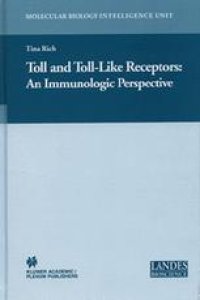
Ebook: Toll and Toll-Like Receptors: An Immunologic Perspective
Author: Tina Rich Ph.D. (auth.)
- Tags: Cell Biology, Immunology
- Series: Molecular Biology Intelligence Unit
- Year: 2005
- Publisher: Springer US
- Edition: 1
- Language: English
- pdf
Toll Receptors and the Renaissance of Innate Immunity Elizabeth H. Bassett and Tina Rich Overview n the last few pages of Immunology: The Science of Self-Nonself Discrimination Jan Klein ponders on what he would study if he were to start over in the lab. ^ Dismissing the I antibody, MHC, the T-cell and parasitology, he considers instead the phylogeny of immune reactions, particularly in ancient phyla. As for a favored cell he chooses the macrophage. Describ ing it as a ^^MddchenfUr alles," (all purpose kitchen maid) Klein believed that this immunocyte still had secrets to reveal. Toll-Like Receptor (TLR) biology would prove to be one of these secrets. Analyses of the evolution of these receptors (Tolls and TLRs) have also helped us to rethink immune system phylogeny. In the first part of this chapter the history of the discovery of Toll and TLR biology is described. The evolution of the TLR genes and theories of immune function are covered in later sections. The remainder of this book presents work from nine groups active in the field. In the first chapter, "The Function of Toll-Like Receptors", Zlatko Dembic sets the stage by introducing us to many of the components of the immune system and their relationships vis a vis Toll receptors. Zlatko finishes his chapter with a discussion about current immune system models and contributes his own 'integrity model'. Work from the laboratory of Nicholas Gay follows this in "Structures and Motifs Involved in Toll Signaling".
Until recently innate immunity was viewed as the poorer relative of the sophisticated adaptive immune response. We now know, however, that these ‘higher’ immune responses are actually underpinned by an elegantly hewn system of innate immune surveillance. Discovered first by developmental biologists, again by immunologists, and even by sociologists, Toll receptors have revolutionized our understanding of innate immunology. Although a small part of a complex system, Toll receptor biology compels us to revisit existing models of self – non-self recognition.
Until recently innate immunity was viewed as the poorer relative of the sophisticated adaptive immune response. We now know, however, that these ‘higher’ immune responses are actually underpinned by an elegantly hewn system of innate immune surveillance. Discovered first by developmental biologists, again by immunologists, and even by sociologists, Toll receptors have revolutionized our understanding of innate immunology. Although a small part of a complex system, Toll receptor biology compels us to revisit existing models of self – non-self recognition.
Content:
Front Matter....Pages i-x
Introduction....Pages 1-17
The Function of Toll-Like Receptors....Pages 18-55
Structures and Motifs Involved in Toll Signaling....Pages 56-93
“Supramolecular” Activation Clusters in Innate Immunity....Pages 94-109
Interleukin-1 Receptor/Toll-Like Receptor Signaling....Pages 110-130
Virus Induced Signaling to Initiate the Interferon Mediated Anti-Viral Host Response....Pages 131-146
The Induction of Dendritic Cell Activation and Maturation by Toll-Like Receptor Signaling....Pages 147-161
Pathogen Avoidance Using Toll Signaling in C. elegans ....Pages 162-167
Forward Genetic Analysis of TLR Pathways....Pages 168-180
Agonists of Toll-Like Receptor 9....Pages 181-212
Back Matter....Pages 213-218
Until recently innate immunity was viewed as the poorer relative of the sophisticated adaptive immune response. We now know, however, that these ‘higher’ immune responses are actually underpinned by an elegantly hewn system of innate immune surveillance. Discovered first by developmental biologists, again by immunologists, and even by sociologists, Toll receptors have revolutionized our understanding of innate immunology. Although a small part of a complex system, Toll receptor biology compels us to revisit existing models of self – non-self recognition.
Content:
Front Matter....Pages i-x
Introduction....Pages 1-17
The Function of Toll-Like Receptors....Pages 18-55
Structures and Motifs Involved in Toll Signaling....Pages 56-93
“Supramolecular” Activation Clusters in Innate Immunity....Pages 94-109
Interleukin-1 Receptor/Toll-Like Receptor Signaling....Pages 110-130
Virus Induced Signaling to Initiate the Interferon Mediated Anti-Viral Host Response....Pages 131-146
The Induction of Dendritic Cell Activation and Maturation by Toll-Like Receptor Signaling....Pages 147-161
Pathogen Avoidance Using Toll Signaling in C. elegans ....Pages 162-167
Forward Genetic Analysis of TLR Pathways....Pages 168-180
Agonists of Toll-Like Receptor 9....Pages 181-212
Back Matter....Pages 213-218
....